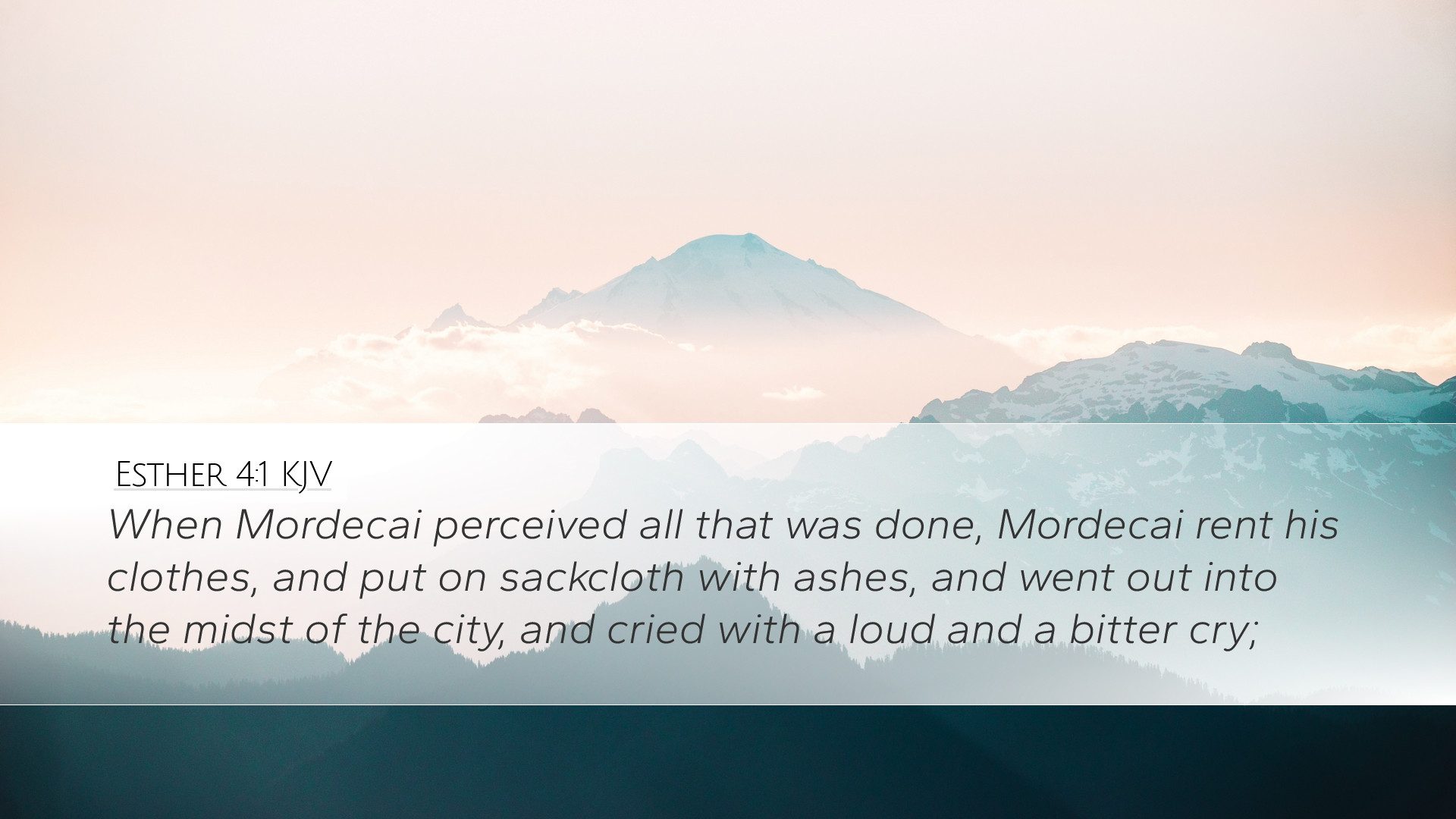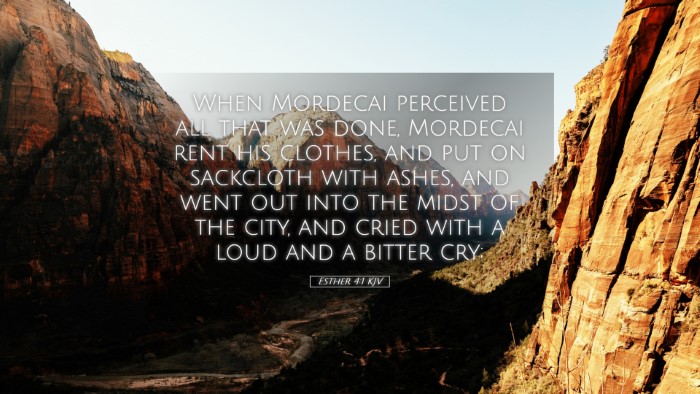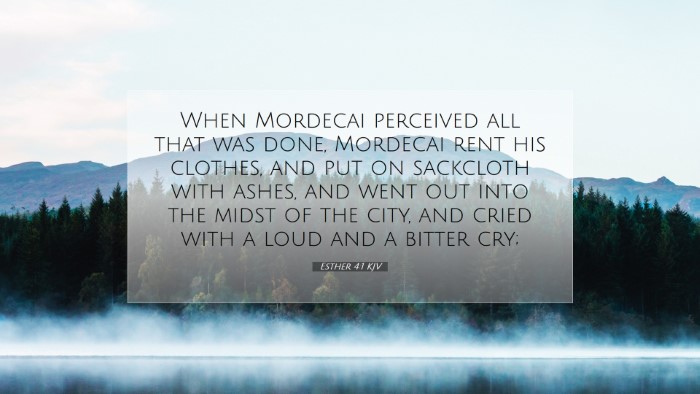Old Testament
Genesis Exodus Leviticus Numbers Deuteronomy Joshua Judges Ruth 1 Samuel 2 Samuel 1 Kings 2 Kings 1 Chronicles 2 Chronicles Ezra Nehemiah Esther Job Psalms Proverbs Ecclesiastes Song of Solomon Isaiah Jeremiah Lamentations Ezekiel Daniel Hosea Joel Amos Obadiah Jonah Micah Nahum Habakkuk Zephaniah Haggai Zechariah MalachiEsther 4:1
Esther 4:1 KJV
When Mordecai perceived all that was done, Mordecai rent his clothes, and put on sackcloth with ashes, and went out into the midst of the city, and cried with a loud and a bitter cry;
Esther 4:1 Bible Commentary
Bible Commentary on Esther 4:1
Introduction
Esther 4:1 is a pivotal verse in the narrative of Esther, marking a moment of deep emotional and spiritual crisis within the Jewish community in Persia. The verse captures the reaction of Mordecai upon learning of Haman's decree to annihilate the Jews, portraying themes of mourning, urgency, and the intercession that becomes paramount in the ensuing chapters. This commentary synthesizes insights from various public domain sources to provide a robust understanding of the implications of this verse.
Verse Context
The Book of Esther presents a unique combination of historical narrative and theological exploration. Set in the court of Xerxes, it depicts the precarious situation of the Jewish exiles and serves as a backdrop for revealing God’s sovereignty and providential care. In this chapter, Mordecai's reaction signifies the gravity of the threat against his people.
Mordecai's Mourning
When Mordecai learns of Haman's edict, he tears his clothes, puts on sackcloth, and begins to wail loudly and bitterly. This act symbolizes profound grief and despair.
- Significance of Sackcloth: According to Matthew Henry, the use of sackcloth is a common expression of mourning in biblical times, denoting seriousness and a call to repentance. It reflects the inner turmoil of Mordecai as he contemplates the impending doom of his people.
- Public Expression of Grief: Albert Barnes highlights that Mordecai's mourning is not only personal but public, indicating that the fate of the Jewish people is a communal issue. His actions serve to rally the Jewish community to recognize the severity of the threat.
The Nature of the Threat
The decree issued by Haman was a direct threat to the Jewish identity, aimed at their complete extermination. This aspect is pivotal in understanding the urgency of Mordecai's mourning.
- Spiritual Dimensions: Adam Clarke notes that Mordecai's reaction is also reflective of a spiritual battle. The annihilation of the Jews was not merely a political event; it bespeaks a larger cosmic struggle against the people of God.
- Historical Context: Mordecai's lineage and his relationship with Esther bring depth to the narrative. As a relative of Esther and a Jew, he carries not just personal grief but the burden of a national crisis.
The Call to Action
Mordecai's mourning serves as a precursor to his call to action. His grief is not passive; it is the catalyst for the courageous stand that he will later urge Esther to take.
- Encouragement to Pray: Matthew Henry emphasizes the importance of prayer and fasting in response to crises. Mordecai’s actions set a tone that aligns with calling upon God for deliverance.
- Leadership in Crisis: Mordecai embodies the leadership needed in times of crisis. He does not recede into despair but rather leads the charge for his people to address their dire circumstances.
The Role of Esther
This verse sets in motion the eventual actions of Esther. Mordecai's grieving draws attention to the choice that Esther must make, positioning her as a key figure in the divine plan.
- Intercession of Esther: In the threats faced, Albert Barnes suggests that Esther represents not just a figure of beauty but one of potential salvation. Her response to Mordecai's urgent need will illustrate the theme of providence, as God uses her for significant purposes.
- The Dangerous Decision: The call for Esther to approach the king is fraught with danger, and Mordecai's mourning highlights the gravity of her task. Adam Clarke interprets this as a moment of purposeful hesitation, a moment where faith is tested and courage is demanded.
Theological Reflections
The emotional response of Mordecai opens avenues for theological reflection, particularly concerning God’s providence and the human response to crisis.
- The Silence of God: The absence of overt mention of God in this text raises critical questions about divine providence. Matthew Henry discusses how the faithful response in times of trial affirms the belief in God’s hidden yet active presence in human affairs.
- Faithful Remnant: This narrative highlights God’s preservation of a faithful remnant, emphasizing that even in dire circumstances, God orchestrates events for His purpose. Albert Barnes notes that the actions taken by Mordecai and Esther reflect the larger narrative of redemption throughout Scripture.
Conclusion
Esther 4:1 is a profound narrative pivot that sets the stage for one of the most dramatic rescue stories in the Bible. The insights from public domain commentaries bring forth not only the historical and theological weight of Mordecai's mourning but also speak to the ongoing struggles of God's people throughout history. For pastors, theologians, and Bible scholars, this verse serves as a poignant reminder of the call to intercede and act in faith, particularly when faced with overwhelming odds.


